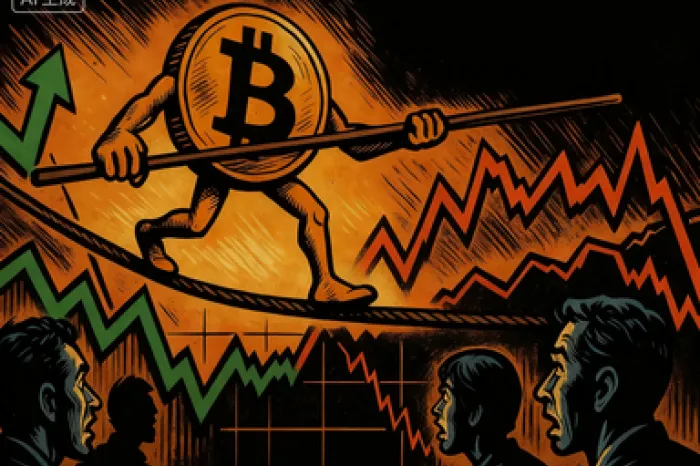Bitcoin’s recent bounce sent some traders dusting off their bull horns, but let’s be real—this rebound is looking more like a fleeting moment of hope in an ongoing bear market than the start of a new rally. As the week progressed, it became increasingly clear that this surge had more to do with short-term sentiment than any real sign of long-term growth. Traders were excited, sure, but the data suggests we’re still in a bearish phase, with any upward moves more likely to be short-covering than a sustainable trend.
A Brief History of Bitcoin’s Latest ‘Bounce’
It all started with some promising headlines: US-China trade negotiations, talks of positive deals, and the kind of risk-on sentiment that tends to boost markets. Bitcoin’s price shot up, and many thought, “Here we go, it’s finally turning around.” But as we all know, hope is not a strategy in the crypto world.
Despite the optimism, Bitcoin’s key technical indicators—volume delta and momentum—stayed weak, suggesting that this upward move was not built on solid ground. While prices briefly soared above the $120,000 mark, they failed to hold. This creates a scenario where the rebound looks more like a corrective rally, not the start of a fresh bull run.
In fact, the 1-month cumulative volume delta (CVD), which tracks buying and selling activity, showed that selling still far outweighs buying. Even as Bitcoin’s price rose, the market didn’t seem all that interested in supporting it at higher levels. Bears are staying put, content to wait for any rally to fizzle out before making their next move.
The Bearish Indicators Are Still Looming
One of the most glaring signals that Bitcoin’s rise is just a blip on the radar is the lack of follow-through on the daily chart. After the price spike, Bitcoin stalled around the 50-day Exponential Moving Average (EMA) on Monday, and the price action formed a small-range session, followed by a spinning-top doji candle. Now, for those of you who don’t spend your days reading candlestick patterns, a spinning-top doji signals indecision in the market, which in this case translates to a lack of bullish conviction.
What’s more, Bitcoin’s Relative Strength Index (RSI) remains under 50, showing that momentum is still on the bearish side. There’s been no bullish divergence either, which means there’s little to suggest that this bounce will lead to anything more than a short-term price swing.
While some bulls are likely holding out hope that the October Value Area Point of Control (VPOC) around $111,700 will offer some support, the general market trend remains tilted towards the downside. This price level might give bulls a brief moment of hope, but it’s unlikely to reverse the overall bearish momentum unless there’s a drastic change in market sentiment.
The Bigger Picture: Bearish Trends on the Horizon
Let’s take a step back and look at the bigger picture. Yes, Bitcoin’s price has been on a wild ride, with some impressive highs since its low in 2022. But when we zoom out and look at the monthly chart, we see something that should be giving Bitcoin bulls a serious case of the jitters: choppy price action and an inability to close above $120,000. That level continues to act as a strong resistance, and it’s been three years without a convincing breakout.
The latest monthly candlestick patterns are showing volatile spinning tops, which historically are a sign of market indecision—hardly the hallmark of a healthy, sustained uptrend. Meanwhile, volume has been steadily decreasing, indicating that the bullish forces behind Bitcoin’s earlier rises may be running out of steam. The market is becoming more erratic, with larger price swings that are starting to favor bears over bulls.
To add insult to injury, Bitcoin futures are also showing signs of weakness. These contracts have been creating volatile, bearish candlestick patterns, which further supports the theory that this bounce is nothing more than a short-covering rally that will soon run its course. The fear is that we’ll see another test of lower price levels, potentially even dipping back below $100,000 as bears continue to take control.
Comparing Bitcoin with Other Cryptos: Not Much Bullish Appetite
Bitcoin isn’t the only cryptocurrency struggling with bearish pressure. Other major coins like Ethereum, Solana, and XRP are showing similar signs of weakness. Ethereum has formed a bearish reversal pattern around the $4,200 mark, and Solana is stuck below $210, unable to maintain upward momentum.
Even Dogecoin, which had a brief moment of fame thanks to Elon Musk’s tweets, is facing a potential bearish continuation, with its chart showing an evening star formation. It’s a sign that the broader crypto market is still very much in the hands of the bears. Litecoin, too, is struggling, as evidenced by a bearish outside day and shooting star candle on its daily chart.
This lack of bullish appetite across the board is a major warning sign for anyone hoping for a massive crypto comeback. The market seems to be in a holding pattern, unsure of whether it wants to go higher or lower. But based on current trends, it’s hard to argue that Bitcoin—and the broader crypto market—has much to cheer about in the short term.
Conclusion: A Cautious Outlook for Bitcoin
While it’s always tempting to get swept up in a price surge, the current Bitcoin rebound should be treated with caution. The market remains fundamentally bearish, and this latest bounce seems more like a temporary relief rally than the start of a new uptrend. Unless there’s a major shift in market sentiment, Bitcoin could very well revisit lower price levels, potentially testing the $100,000 mark or even lower.
So, to all the optimists out there, it might be wise to temper your excitement. Bitcoin has proven time and again that it can surprise us, but for now, it seems like the bears are still in control. Don’t let a short-term price jump fool you into thinking a new bull market is just around the corner—unless, of course, you’re the type to bet on a bear market rally!





























